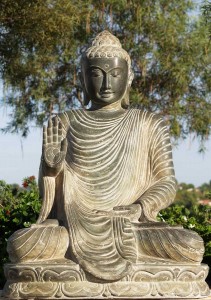Many do not know that there are two major schools of thought within Buddhism. Just as Christianity is split into different sects such as Catholicism and Protestantism, so too is the Buddhist Religion. These two differing schools are known as Theravada and Mahayana.

Theravada Buddhism is a school of thought that stresses the need to follow the teachings of elders. They believe that the longer practicing monks have gained more wisdom; therefore their teachings should be very highly regarded. Younger Theravada monks are passed on with teachings of those that came before them. The main goal of those who practice Theravada Buddhism is to become free of suffering. Shedding the chains of suffering is the ultimate attainment in their eyes. Typically Theravada is practiced in more eastern areas of Asia such as Sri Lanka, Thailand, and Burma.
Mahayana Buddhism on the other hand stresses the importance of following the Buddhas teachings to go out into the world and spread the Dharma to others. They are much more teaching oriented, believing that one’s own worship is just as important as spreading wisdom on to others. Mahayana literally translates to mean ‘the Great Vehicle’ which is metaphor for the spreading of Buddhist teachings throughout the world. Mahayana monks are a vehicle for knowledge, passing that knowledge unto others. These monks are known as Bodhisattvas. Mahayana Buddhism is mostly practiced in countries such as China, Tibet, Vietnam, and Japan.
Although these schools of thought originate and are practiced widely in the Far East, both schools have made their way into the west. Many westerners may choose one school over the other in their practice, or take principles and examples from both. Both schools are centered around the same teachings but hold special importance on ways to live and practice, one focusing more on individual practice, and the other more on teaching to others.
